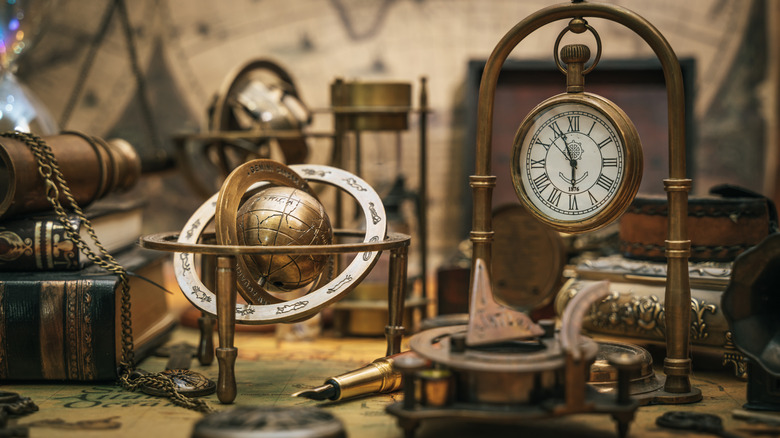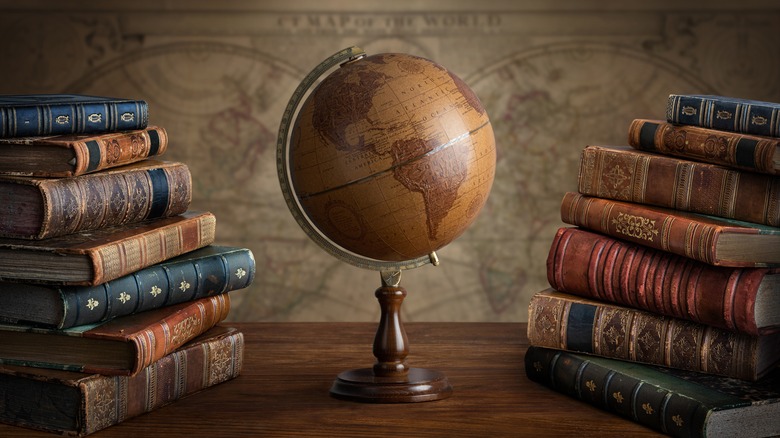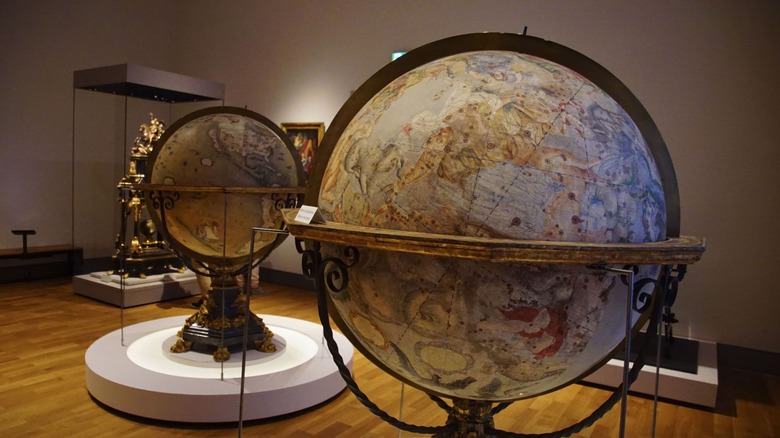Why You Should Seek Out Valuable Vintage Globes At Thrift Stores And Estate Sales
Old, sepia-toned globes seem to be a hallmark of higher learning. That they end up in so many ancient libraries surrounded by great volumes of literature and history attest to their place in the world of knowledge – pun only slightly intended. For avid history buffs and retro decor lovers, scoring a vintage globe at a thrift store or estate sale offers a special thrill. An old globe is an unobtrusive way to add real financial value to your stash of antiques and collectibles. It won't look out of place next to a pile of vintage books and yet, it could be something that could fetch serious cash – several thousand dollars, to be exact — if you were to ever take it to auction or look for a private buyer for it. Aside from that, displaying an old globe among your decorative items shows off a love of travel and history without you ever having to express your interest in those topics outright.
Generally speaking, the older the globe is, the more valuable it becomes. The oldest known globe — a terrestrial globe – was made in Germany in 1492. However, you don't need to look for a globe that is that old. You'll find a valuable globe among antiques from the 17th, 18th, and 19th centuries. Among the most valuable of those are the 17th-century globes by Willem Janszoon Blaeu, a cartographer born in the Netherlands in the late 1500s. Globes and maps of those eras represented more than just an interest in geography and travel. The people who kept them telegraphed their wealth and business dealings via their globe- and map-collections.
What to look for when buying a 20th-century globe
If you can't find a date on a globe, (or you think it may not be valuable because it was made in the 20th century), there are some markers you can check for to determine how valuable the globe is. These markers have to do with the changing borders and country names, thanks to ever-evolving world events. For example, if you've found an old globe that has Russia in Eurasia instead of the Soviet Union, it could be one made before 1922. In 1930, Constantinople changed names to become Istanbul. Additionally, a globe created before the 1930s won't have Israel, which didn't become a country until 1948. And prior to 1957, Ghana was known as the Gold Coast of Africa. Another place you can look is at Australia. Globes before the 18th century would have called it New Holland and not all of its landmass would have appeared on the map. Globes that include East and West Germany would have been made before the fall of the Berlin Wall in 1989. And any globe made during World War II would likely be valuable due to changing border lines.
You can also look for globes with unusual features, like the puzzle globes, which came out in 1926 and 1927. Those break apart to become fitted puzzles in the shape of a globe. Due to the cost to make the metal globes and the effects of the Great Depression, production on those were halted. Those were made by the Geographic Educator Corporation. Despite being from the 20th century, these globes would have been rare, and therefore, valuable.
Valuable terrestrial and celestial globes
The globes on those online estate sales or auctions that feature the night skies instead of the Earth can be just as valuable as their terrestrial counterparts. Although Willem Janszoon Blaeu made celestial globes, he wasn't the first to create such an orb. The production of those stretches all the way back to the second century. There was a time when a well-stocked library included both terrestrial and celestial globes due to people's interest in astronomy. Generally speaking, names to look for on old globes include Cary's, The Geographia Map Company, Rand McNally & Co., (of course), and the Bardin family, to name a few.
Among the most unusual and the most valuable of these terrestrial/ celestial globes are the pocket globes. These pocket-sized globes – hence, the name – were common in the late-1700s. One example, made by Lane's Improved Globe London (which was probably the work of Nicholas Lane), could fetch several thousand dollars at auction, despite the fact that the globe was literally small enough to fit in the palm of your hand and covered with a painted fish skin cover. Inside the cover was a miniature treasure to behold, once you get past the fish skin. The inside of the cover housed a celestial map that encased the little palm-sized globe.
Finally, it's worth noting that not all expensive globes are old. The most expensive globe on the planet right now comes from Hammacher Schlemmer and costs $14,000, due to how detailed it is. It boasts 28,000 place names. With that kind of detail, it's likely to become something to be valued in future generations as the world changes yet again.


